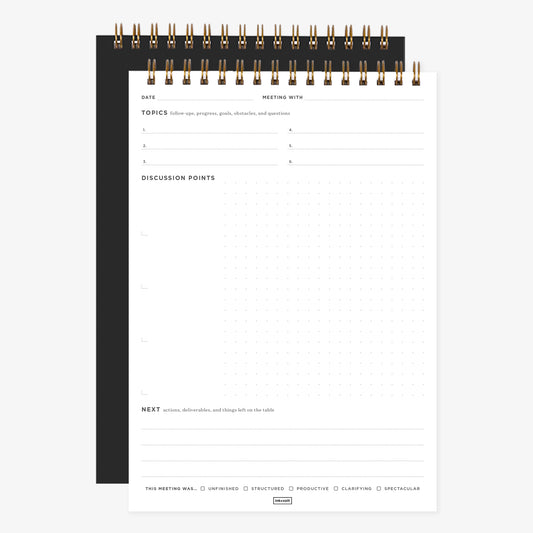2020 is halfway over. Are you where you thought you’d be?
This year has been full of changes, challenges, and surprises to say the least -- so it’s okay if your answer is no.
Whether or not your company does mid-year reviews, the halfway point of the year is the perfect time to check in on your goals, both personal and professional.
Goal-setting shouldn’t be a once-a-year thing — something you only do at the beginning of each year and then forget about after a couple of months. Meeting your goals requires constant review and reflection so that you can be honest with yourself about the progress that you’ve made and adjust your course forward accordingly.
To help you make this planning session as productive as possible, we’ve created a FREE mid-year review worksheet. Click here to download it, and keep reading as we walk you through the process!
As you’re going through the process of self-reflection and planning for the next six months, we want to see your work! We’re hosting an Instagram giveaway every week of July.
To enter: share a piece of your mid-year review process to your Instagram (Stories or Feed), tag us (@inkandvolt), and use #inkandvolt, and you’ll be entered for a chance to win a notebook plus one of our best-selling productivity pads each week!
Tell us how your goals are going, how you’re recommitting to making the most of the next six months, or show us your review/planning session. We can’t wait to cheer you on.
Now let’s dive in to your mid-year review session:
Mid-Year Review Step 1: Check In
The first step with any mid-year review or reflection is to take some time to check in on your progress. Be honest with yourself, and also kind. If you’re not where you thought you’d be by now, that’s okay.
First, think about and write down the noteworthy moments and great memories that you have from the past six months. What stands out? And why?
Next let’s take some time to celebrate: what accomplishments have you made in the last six months? What are you most proud of? Even if you haven’t made as much progress as you might have hoped by now, there are still wins you can find to celebrate. Try noticing and honoring even the smallest of achievements — like flossing for two weeks straight, or trying a new home exercise routine. Those small wins add up to overall big feelings of happiness and well-being.
Now it’s time to get real: where have you fallen short in the last six months? No judgment here, just be honest with yourself. We can often learn more from our mistakes than we can from our successes, so take some time to consider what you can take from your experiences and how you can grow going forward.
Life is full of unexpected changes and challenges — what unexpected things have come up for you in the last few months? And how did you address them? Make sure you write down both the changes you’ve identified *and* how you’ve adjusted your game plan or accommodated them. Being explicit about the challenges you’ve faced and how they’ve impacted you in this way is not making excuses; it’s looking realistically at the whole picture.
Mid-Year Review Step 2: Get Aligned
The good news? There are still six whole months left in the year! That’s plenty of time to make serious progress on your goals. In this section of the mid-year review, we’ll reflect on your big picture and the work you need to do to get back on track, or to stay the course if you never left.
First, take some time to revisit the big picture. What was your vision for this year? What were your biggest goals? Next let’s reflect on the last six months. Were the actions you took aligned with your vision? If so, awesome job — take some time to celebrate that! If not, think about why that might have happened, and what measures you might take to ensure you stay aligned going forward.
After that, it’s time for some good old fashioned graphing. We love using a pie chart to get a visual representation of balance. So draw a big circle on your paper and divide it up into how your time over the last six months was spent. What can you learn from this? Maybe you’re spending a disproportionate amount of time watching Netflix instead of working on your goals. Or maybe you’re prioritizing other people’s work ahead of your own. Think about the steps you can take in the next six months to ensure that your pie chart is a little more balanced and in line with the vision you set for your year.
Now that you’ve taken a hard look at where you’ve been and the progress you’ve made over the first half of the year, it’s time to start looking ahead: How might you need to restructure or reset your goals at this point to stay aligned with your vision?
Mid-Year Review Step 3: Finish Strong
The third and final step in our mid-year review is to make a game plan for the next six months to make sure you finish the year strong. There’s still time to make meaningful progress!
In this section, we’ll help you visualize your goals and your timeline for completing them in a few different ways.
First up: 30-day challenges. One of the key elements in our planners is the 30-day challenge because we believe that making small, consistent progress toward a goal adds up to big successes over time. By committing to doing something for 30 days, you’re jumpstarting the habit-forming process needed to start making a positive practice part of your long-term routine.
Since there are six months left in the year, commit *now* to the 30-day challenges you’ll take on each month. It could be the exact same challenge every time, or you could set an individual theme for each month. If you’re feeling stuck, we have lots of 30-day challenge ideas for you here and here, as well as custom export-produced challenges:
- Shira Gill’s declutter and home organization challenge
- Anupy Singla’s “spice it up” kitchen challenge
Now that you’ve nailed down the challenges you’re going to commit to each month, it’s time to start setting other deadlines. Draw a timeline on your paper and create a segment for each month through the end of the year. What will you accomplish each month?
Remember to make sure your goals are SMART — specific, measurable, achievable, realistic, and time-bound. (That means instead of saying, “Get in shape,” you’ll set a goal like, “Work out for 30 minutes a day, three times per week.”)
Writing down your goals makes you 30% more likely to achieve them, so even this small action of setting dates and deadlines for your progress is helping to keep you on the right track.
With your revised goals written down and your plan of action in-hand, you are ready to take on the next six months and be more successful than ever! We can’t wait to see what you accomplish.









